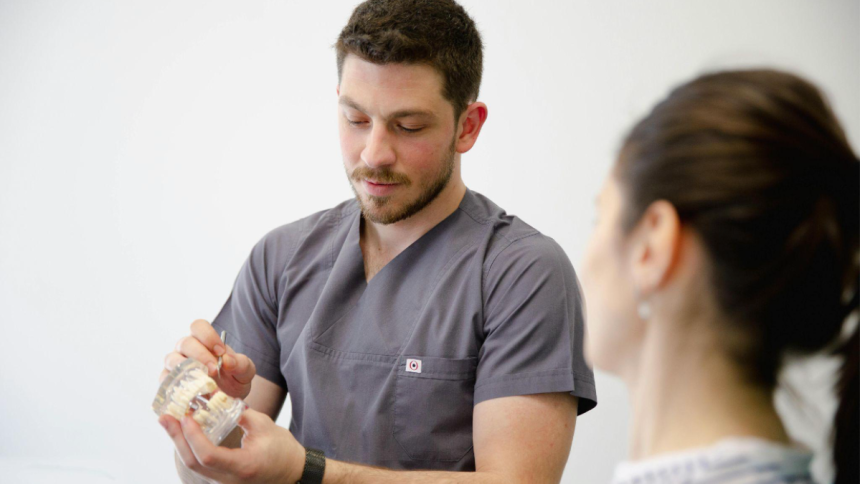Orthodontics in Manhattan is at the forefront of transforming smiles through the adoption of modern techniques. The integration of invisible aligners, 3D imaging, and digital scanning technologies is reshaping the landscape of orthodontic care. These advancements enable personalized treatment plans, streamline diagnostics, and enhance efficiency. As Manhattan practices embrace these innovations, they prioritize precision-driven therapies and elevate patient satisfaction. Discover how these cutting-edge methods are redefining orthodontic outcomes and the patient experience.
The Rise of Invisible Aligners in Modern Orthodontics
In recent years, the orthodontic landscape has transformed substantially with the advent and widespread adoption of invisible aligners. These modern orthodontic solutions have revolutionized patient care by offering an aesthetic and convenient alternative to traditional braces. Central to this evolution is the emphasis on patient personalization, which allows for the creation of customized aligners tailored to the unique dental structures of each individual. This personalization is achieved through detailed assessments of the patient’s dental anatomy, ensuring ideal alignment and comfort. The customized aligners are produced using advanced materials that facilitate effective tooth movement while maintaining transparency. This technological advancement not only enhances patient satisfaction due to improved aesthetics and comfort but also contributes to more efficient treatment outcomes, reflecting a significant shift in orthodontic practices.
The Role of 3D Imaging in Personalized Treatment Plans
3D imaging technology drastically enhances diagnostic accuracy in orthodontics by providing detailed visualizations of dental structures. This advanced imaging allows orthodontists to craft tailored treatment plans that address the unique dental needs of each patient, improving outcomes and efficiency. As a result, personalized orthodontic solutions are more achievable, leading to increased patient satisfaction and treatment success.
Enhanced Diagnostic Accuracy
While technological advancements continue to revolutionize orthodontic practices, the implementation of 3D imaging stands out as a pivotal tool in enhancing diagnostic accuracy. This innovation offers enhanced patient screening capabilities, allowing for thorough visualization of craniofacial structures. By capturing high-resolution images, orthodontists can employ improved diagnostic techniques to precisely assess dental and skeletal anomalies. The three-dimensional perspective facilitates detailed examination of complex anatomical relationships, providing insights unattainable with traditional two-dimensional radiographs.
Moreover, the integration of 3D imaging into orthodontic workflows enables practitioners to identify discrepancies and plan interventions with unprecedented precision. This advanced imaging technology supports the development of personalized treatment plans, ensuring that each patient’s unique dental structure is meticulously evaluated. Consequently, 3D imaging not only optimizes diagnostic proficiency but also enhances treatment outcomes, setting a new standard in orthodontic care.
Tailored Orthodontic Solutions
As orthodontic practices evolve, the role of 3D imaging in crafting tailored treatment solutions becomes increasingly significant. This technology enables precise visualization of dental structures, facilitating personalized planning in orthodontics. By creating detailed digital models, orthodontists can assess individual dental anatomy with unparalleled accuracy, leading to customized solutions that cater to unique patient needs.
In Manhattan, the integration of advanced 3D imaging techniques emboldens practitioners to develop inclusive treatment plans that are both efficient and effective. This approach not only enhances the predictability of outcomes but also optimizes treatment duration and comfort. Additionally, the ability to simulate treatment scenarios using 3D models guarantees informed decision-making, thereby improving patient satisfaction. As a result, orthodontic care is increasingly moving towards precision-driven, individualized therapy.
Digital Scanning: A Game-Changer for Precision and Comfort
Digital scanning technologies have revolutionized orthodontics by enhancing precision in treatment outcomes and elevating patient comfort. These advanced systems facilitate a more accurate capture of dental structures, leading to improved diagnostic accuracy and faster treatment planning. Additionally, the streamlined scanning process reduces chair time, considerably enhancing the overall patient experience.
Enhanced Accuracy in Treatment
In recent years, the integration of digital scanning technology has revolutionized orthodontic practices, offering unprecedented precision and comfort in treatment planning. This innovation allows for the creation of highly detailed three-dimensional models of a patient’s dental structure, facilitating more precise tooth movement. By capturing accurate measurements of teeth and surrounding tissues, orthodontists can devise tailored treatment plans that optimize the alignment process. The precision afforded by digital scanning not only enhances the accuracy of braces and aligner placements but also contributes to lessened treatment duration. These digital impressions eliminate the need for traditional molds, considerably improving the accuracy of initial assessments. Consequently, patients benefit from a streamlined process, experiencing fewer adjustments and achieving desired outcomes more efficiently.
Improved Patient Experience
How has the orthodontic experience evolved with the advent of digital scanning technology? Digital scanning has transformed orthodontics by considerably enhancing improved patient comfort and precision in diagnostics. Traditional impression materials, often uncomfortable for patients, are being replaced by non-invasive, high-resolution digital scanners. This advancement not only alleviates discomfort but also allows for accurate capture of oral structures, leading to the creation of more personalized treatment plans. Orthodontists can now design tailor-made solutions that precisely fit the unique dental anatomy of each patient. This technology guarantees that treatment interventions are highly specific, optimizing outcomes and enhancing patient satisfaction. By reducing the need for physical impressions, digital scanning represents a pivotal advancement in the patient experience, guaranteeing comfort and tailored care.
Speedier Diagnostic Processes
With the integration of digital scanning technology, orthodontic diagnostics have become significantly faster and more efficient. This innovation enables practitioners to capture highly detailed 3D images of patients’ dental structures in minutes, vastly reducing the time required compared to traditional methods. The precision of digital scans facilitates expedited appointment scheduling, as the need for physical impressions is eliminated, allowing for immediate analysis and treatment planning. Furthermore, it supports a streamlined diagnostic workflow by seamlessly integrating with orthodontic software systems, consequently enhancing data management and accuracy. Patients benefit from increased comfort, as digital scans are non-invasive and negate the discomfort associated with conventional molds. This advancement represents a pivotal shift in orthodontic practice, prioritizing both precision and patient-centric care.
How Modern Techniques Are Improving Treatment Efficiency
Advancements in orthodontic technology have substantially enhanced treatment efficiency, revolutionizing patient care standards. Cutting-edge techniques have enabled streamlined treatment workflows, minimizing unnecessary steps and procedures. This innovation allows for more precise, predictable outcomes, ensuring that each phase of treatment is meticulously planned and executed. By integrating digital tools, orthodontists can generate accurate models for treatment planning, reducing the need for manual adjustments.
Optimized chair time is a critical component of these modern advancements. Through the use of advanced imaging and modeling technologies, patients experience shorter visits and reduced overall treatment duration. This efficiency is achieved without compromising the quality of care, as the precision of these technologies supports superior alignment outcomes. Consequently, orthodontic practices are able to accommodate more patients while maintaining high service standards.
Enhancing Patient Experience With Advanced Technology
By leveraging advanced technology, orthodontic practices are vastly enhancing the patient experience. Integrating tools like 3D imaging and digital scanning, practitioners can offer personalized patient experiences tailored to individual needs. This guarantee that treatments are more effective and aligned with patient expectations. Additionally, the adoption of automated systems enables streamlined appointment workflows, minimizing wait times and optimizing scheduling efficiency. Patients benefit from reduced in-office visits through remote monitoring and digital consultations, fostering convenience and flexibility. These technological advancements not only improve clinical outcomes but also enhance patient satisfaction by addressing modern demands for efficiency and customization. Consequently, the implementation of such innovations positions orthodontic practices at the forefront of providing superior patient care in an increasingly digital healthcare landscape.
The Impact of Innovative Methods on Smile Aesthetics
Numerous orthodontic practices are employing innovative methods to substantially enhance smile aesthetics, focusing on improving both structural alignment and visual appeal. Advanced techniques, such as clear aligners and 3D imaging, allow for precise customization of treatment plans, ensuring personalized smile transformations. By leveraging these technologies, Orthodontics in Manhattan can achieve enhanced smile aesthetics through minimally invasive procedures, reducing treatment time and discomfort. The utilization of digital modeling facilitates accurate prediction of outcomes, enabling practitioners to tailor interventions that harmonize with facial features. Additionally, modern materials contribute to improved aesthetics by providing discreet, yet effective, solutions. As a result, patients benefit from increased confidence and satisfaction, underscoring the significance of these advancements in contemporary orthodontic care. Such innovations are pivotal in redefining traditional orthodontic paradigms.
Accessibility of Cutting-Edge Orthodontic Care in Manhattan
How accessible is cutting-edge orthodontic care in a bustling metropolis like Manhattan? The city offers a plethora of advanced orthodontic services, designed to meet the demands of its diverse population. Accessibility is enhanced through convenient scheduling options, accommodating the busy lifestyles of Manhattan residents. Many clinics extend their hours, offering evening and weekend appointments to guarantee flexibility. Additionally, personalized payment plans facilitate financial accessibility, enabling patients to manage costs effectively without compromising care quality. These plans often include zero-interest financing and sliding scale fees, tailored to individual financial situations. The integration of digital communication tools further simplifies the patient experience, allowing seamless appointment bookings and consultations. Overall, these features confirm that advanced orthodontic care is within reach for Manhattan’s populace.
The Link Between Modern Orthodontics and Oral Health
Advanced orthodontic care’s accessibility in Manhattan sets a foundation for enhancing oral health through modern techniques. Orthodontists employ personalized treatment plans designed to align teeth in an ideal manner, which has a profound impact on oral health. Misaligned teeth can lead to issues such as tooth decay and gum disease due to difficulty in cleaning. Comprehensive oral assessments allow orthodontists to identify these underlying issues early. By correcting dental misalignments, modern orthodontic techniques reduce the risk of periodontal problems and improve the overall function of the teeth and jaw. In many cases, patients also explore complementary treatments through cosmetic dentistry in NYC to address aesthetic or structural concerns beyond orthodontics. Additionally, these personalized approaches contribute to better long-term oral hygiene practices. In Manhattan, state-of-the-art orthodontic interventions not only enhance aesthetic appeal but also considerably fortify oral health by addressing and mitigating potential dental concerns.
Future Trends in Orthodontic Technology and Patient Care
As the field of orthodontics continues to evolve, emerging technologies and innovative patient care approaches are poised to transform the landscape drastically. Advanced diagnostics, such as 3D imaging and digital scanning, are enhancing the precision of assessments, allowing for more accurate identification of dental issues. These technologies facilitate personalized treatment planning, tailoring interventions to the unique needs of each patient. The integration of artificial intelligence in treatment algorithms is further refining these plans by predicting outcomes and optimizing efficiency. Additionally, the use of clear aligners and self-ligating braces is increasing due to their aesthetic appeal and comfort. Remote monitoring tools are also gaining traction, enabling continuous patient engagement and timely adjustments without frequent in-office visits, thereby enhancing overall care delivery.
Frequently Asked Questions
How Does Orthodontic Treatment Affect Speech?
Orthodontic treatment can influence speech by causing temporary speech impediments and articulation challenges. Adjustments in oral structures, such as braces or aligners, may initially disrupt normal speech patterns as individuals acclimate to these new oral conditions.
What Age Is Ideal to Start Orthodontic Treatment?
The ideal age to start orthodontic treatment often aligns with early childhood development stages, around ages 7-9. This timing allows for skeletal maturity considerations, enabling effective intervention as facial structure and jaw alignment begin to solidify.
Are There Dietary Restrictions During Orthodontic Treatment?
During orthodontic treatment, patients must adapt food choices and eating habits to protect appliances. Hard, sticky foods can damage braces, while softer foods are recommended to guarantee treatment effectiveness and minimize the risk of appliance breakage.
How Often Are Follow-Up Appointments Needed in Modern Orthodontics?
Follow-up appointments in modern orthodontics are typically scheduled every 4-6 weeks. These visits guarantee compliance monitoring and allow for necessary treatment adjustments, optimizing patient outcomes and confirming the progress aligns with the prescribed orthodontic plan.
Do Modern Orthodontic Techniques Reduce Treatment Discomfort?
Modern orthodontic techniques markedly diminish pain levels and enhance comfort for patients. Innovations such as advanced materials and digital imaging amplify precision and efficacy, mitigating discomfort traditionally associated with braces and aligners, consequently optimizing the overall treatment experience.
Lynn Martelli is an editor at Readability. She received her MFA in Creative Writing from Antioch University and has worked as an editor for over 10 years. Lynn has edited a wide variety of books, including fiction, non-fiction, memoirs, and more. In her free time, Lynn enjoys reading, writing, and spending time with her family and friends.















